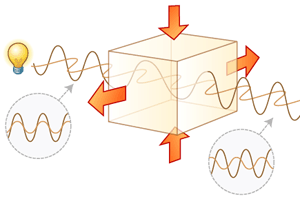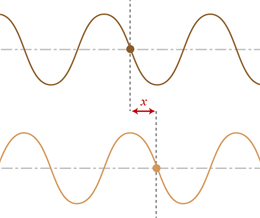About Birefringence
The refractive index of a transparent material is a dimensionless property which specifies the factor by which light slows down as it travels through the material. For most materials the refractive index is independent of the direction of travel and polarization of the light. However, stress can alter the refractive index of a material. If the stress is different in different directions then the material's refractive index may depend on the polarization of the incident light. This phenomenon is known as birefringence.

Figure 1: Birefringence in a transparent material caused by stress. Horizontally- and vertically-polarized light travels at different speeds through the material and emerges out of phase.
Note: Some crystals have a natural optical axis and exhibit birefringence even when not under stress. Crystalline birefringence is less important than stress birefringence in thermoplastic analysis because most plastics are amorphous.
Stress birefringence
In amorphous materials, the refractive index for light polarized along an axis varies proportionally to both the linear stress in that axis and the transverse stress perpendicular to that axis. These proportions are called the stress-optic coefficients and are a property of the material type.
Visual effects of birefringence
Birefringence leads to two different visible effects, depending on the orientation and polarization of the incident light and the principal stress directions in the material. Both effects are generally undesirable in parts that are intended for optical purposes.
Retardation
Normal light is unpolarized, which is to say that it contains multiple beams, polarized in all possible directions perpendicular to the direction of travel. When light enters a birefringent material, it decomposes into component beams polarized along each of the principal stress directions. Each of these beams experiences a different refractive index and so emerges from the material having traveled at different speeds. When the components are recombined they are out of phase. This phase difference is sometimes known as retardation. The transmitted beam may consequently have a different polarization direction (or distribution of polarization directions) than the incident beam. If the light was initially polarized, or is subsequently polarized, then its components may destructively interfere, leaving alternating bands of darker and lighter transmission. This effect is visible by placing the material between two crossed polarizing filters.

Figure 2: Retardation. Horizontally and vertically-polarized light waves emerge offset by a distance x. This can be expressed absolutely as a length, or as a fraction of a wavelength (one quarter of a wave, or 90°).
Double images
If the light's direction of travel is not parallel to one of the principal stress directions then one polarized component beam (the extraordinary beam) may refract even if the incident light is normal to the material surface. When it emerges from the material the beam is offset from the other (ordinary) beam, leading to double images.
